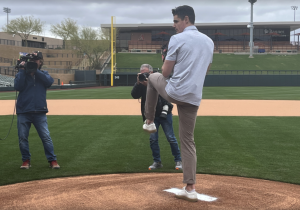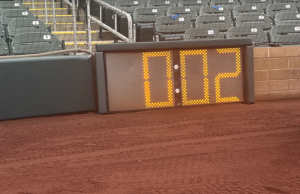- Slug: Sports-MLB Rules Demonstration, 950 words
- 3 photos available (thumbnail, caption below)
By Lauren Hettz
Cronkite News
SCOTTSDALE – Bigger bases, no defensive shifts and a pitch clock.
When Major League Baseball announced the three major rule changes coming to America’s pastime back in September, many had mixed feelings as to how the changes would affect the game.
The rule changes had been in effect during the 2022 minor league season and the Arizona Fall League, but Tuesday’s demonstration at Salt River Fields showed members of the media the first look into the finalized changes for the 2023 season.
“Fans want shorter games. If you ask fans open-ended questions about how long would you like a baseball game to be? The answer is two hours and 30 minutes,” said Morgan Sword, executive vice president of baseball operations at MLB. “This past season our average game (was) three hours and seven minutes. Obviously, we’re missing the mark a little bit there.”
With the introduction of the pitch clock, MLB hopes the game time will speed up. Since the 1950s, the speed of an average game has slowed down by 37 minutes, but the goal remains to bring baseball back to the forefront of American sports.
Reds first baseman Joey Votto said in a statement that he wished he had the pitch clock his entire career, and feels like he’s played an additional 50 games a season with the current format.
The average time between a batted ball event currently stands at 3.9 minutes, compared to 2.5 minutes back in the 1950s. Beginning this season, the pitcher will have 2:15 between innings to warm up, 30 seconds between batters, 15 seconds between pitches if the bases are empty, but 20 seconds if a runner is on base.
However, beginning with the start of spring training, a pitcher must now begin the motion of throwing a pitch before the expiration of the timer. If the pitcher violates the clock, they will be hit with an automatic ball, but if a batter violates the clock by not being in the batter’s box and alert by the eight-second mark, they will be charged with an automatic strike.
Umpires will have a buzzer on their belt pack to alert them when the timer is down to zero, although there will be two timers located in the outfield and one behind home plate.
“What we were looking at in the minor leagues should have some indication of what we expect to see this season,” Sword said. “This past season has been tested to know, not only that the number is very large, (the average time of a game was reduced by 25 minutes last season with the pitch timer in the minor leagues) but the field and the pace and rhythm of that game is almost unrecognizable.”
According to Joe Martinez, a former major league pitcher who is now vice president of on-field strategy at MLB, a pitcher will be limited to two times where they’re allowed to step off the rubber per plate appearance, but the number can be reset if a runner advances or when they step off the mound.
MLB expects the first week of spring training to be an adjustment for most, with 48% of minor league pitchers last season needing a week, 28% a couple of weeks and 13% a month to adjust. From the second week to week 24 of the minor league season, the violations went down from 1.73 on both teams per game in week two to 0.41 violations by the end of the season.
While the pitch clock is the biggest change coming to the major leagues, the banning of the shift brings more extra base hits and stolen base opportunities than before.
“So each club used to have at least four inferiors inside the border between the infield and the outfield. Secondly, each team needs to have at least two infielders on each side of second base. When the pitch is released, you can have more than two, but at least two,” Sword said.
“Lastly, there’s a prohibition on switching your infielders back and forth within an inning. In the first pitch, the plate appearance, the two guys that are on the left side of your infield and the two guys that are on the right side of your infield are locked in for that inning unless there’s a substitution. But then in the next inning, they can come out in any alignment we want.”
Infields will now be measured early in the season using radar technology and the penalty for violating the rule will be an automatic ball.
While the pitch clock and the ban of the defensive shift aim to speed up the game, increasing the bases by 3 inches and decreasing the distance in between the bases by 4.5 inches prevented injury in the minor leagues by 13% from 2021-22 and increased successful stolen base attempts.
Martinez hopes that with the bigger bases, less collisions will occur and more stolen base attempts will take place. The ultimate goal for MLB is to accelerate the game, while also maintaining tradition for both older and new fans.
The first time the fans will see the rule changes in full effect is Feb. 24, and MLB hopes that with the first “normal” spring training since 2019, the rule changes will bring freshness to America’s pastime.
“More fans have a connection with the game that allows fans to generate a strong lifelong connection to baseball,” MLB Chief Operations and Strategy Officer Chris Marinak said. “More fans have attended baseball games, than any other fans of any other sport. Baseball has more second and third-generation fans, meaning that the fandom is passed on through generations. We think it is a unique year for baseball. It’s really a year for us to build on our innovations and existing courses (with the rule changes).”
For more stories from Cronkite News, visit cronkitenews.azpbs.org.


